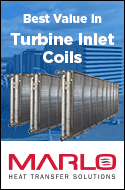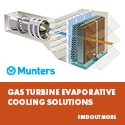Technology Overview
INTRODUCTION
This section addresses two of the following frequently asked questions: What is TIC? Why Cool Turbine Inlet Air?What is TIC?
A typical schematic flow diagram of a combustion turbine (CT) system is shown in Figure 1. TIC is cooling of the ambient air before it enters the compressor that supplies high-pressure air to the combustion chamber from which hot air at high pressure enters the combustion turbine. TIC is also called by many other names, including combustion turbine inlet air cooling (CTIAC), turbine inlet air cooling (TIAC), combustion turbine air cooling (CTAC), and gas turbine inlet air cooling (GTIAC).

Figure 1. Schematic Diagram of a Typical CT System
Why Cool Turbine Inlet Air?
The primary reason turbine inlet air is cooled is to reduce or prevent the often significant loss of power output, compared to the rated capacity, of combustion turbines when ambient air temperature is high. TIC can even help to enhance CT output above its rated capacity. TIC is applicable to all combustion turbines (CTs), whether operating in simple-cycle, cogeneration, and combined-cycle systems.
The rated capacities of all CTs are based on the standard ambient air conditions of 59oF and 14.7 psia at sea level, as selected by the International Standards Organization (ISO). One unattractive characteristic of all CTs is that their power output decreases as the inlet air temperature increases as shown in Figure 2.

Figure 2. Effect of Ambient Temperature on the Output of CTs
It shows the effects of inlet air temperature on power output for two types of CTs: Aeroderivative and Industrial/Frame. The data in Figure 2 are typical for the two types of turbines. The actual characteristics of each CT could be different depending on its actual design.
The data in Figure 2 show that for a typical aeroderivative CT, an increase in inlet air temperature from 59oF to 100oF on a hot summer day, decreases power output to about 73% of its rated capacity. This could lead to a loss of opportunity for power producers to sell more power just when the rise in ambient temperature increases power demand for operating air conditioners.
By cooling the inlet air from 100oF to 59oF, we could prevent the loss of 27% of the rated generation capacity. In fact, if we cool the inlet air to about 42oF, we could enhance the power generation capacity of the CT to 110% of the rated capacity. Therefore, if we cool the inlet air from 100oF to 42oF, we could increase power output of an aeroderivative CT from 73% to 110% of the rated capacity or boost the output capacity by about 50% of that at 100oF.
How Does TIC Help Increase CT Output?
Power output of a CT is directly proportional to and limited by the mass flow rate of compressed air available to it from the air compressor that provides high-pressure air to the combustion chamber of the CT system. An air compressor has a fixed capacity for handling a volumetric flow rate of air for a given rotational speed of the compressor. Even though the volumetric capacity of a compressor is fixed, the mass flow rate of air it delivers to the CT changes with fluctuations in ambient air temperature. This mass flow rate of air decreases with an increase in ambient temperature because the air density decreases when air temperature increases. Therefore, the power output of a combustion turbine decreases below its rated capacity at the ISO conditions (59oF and 14.7 psia at sea level) with increases in ambient temperature above 59oF. TIC allows an increase in air density by lowering the temperature, and thus, helps increase the mass flow rate of air to the CT and results in increased output of the CT.




